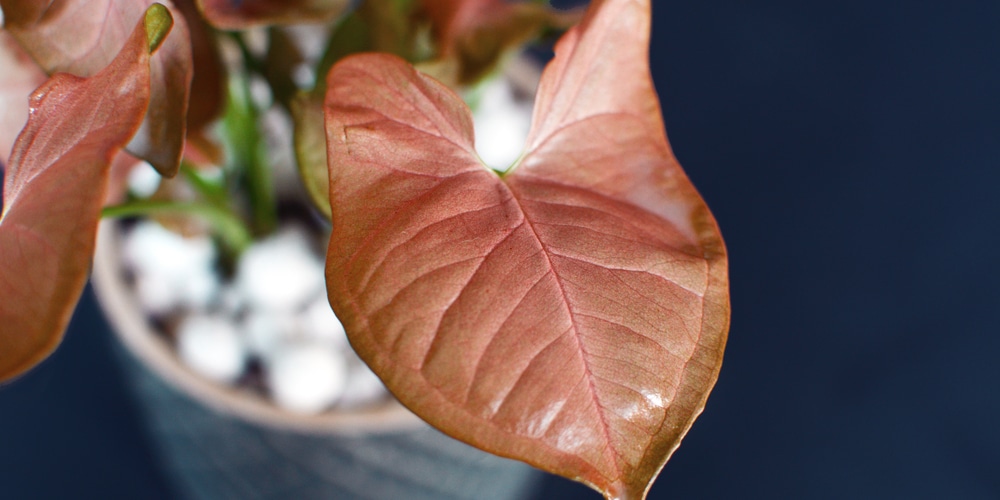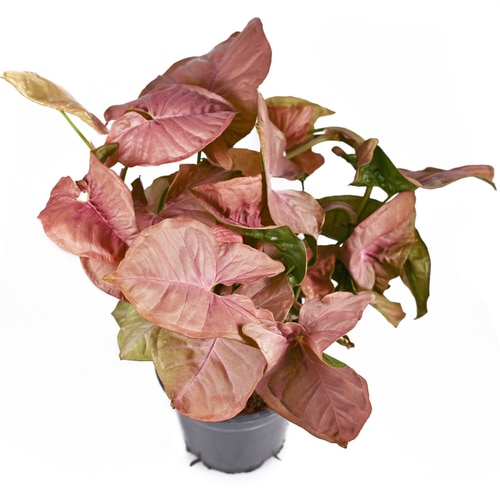Pink Syngonium plants are unique houseplants with attractive pink leaves. They are also commonly referred to as Arrowhead plants or the arrowhead vine, or Goosefoot due to the shape of their leaves. Pink Syngonium has the scientific name Syngonium podophyllum.
Pink Syngonium is very popular amongst plant lovers worldwide. They have pinks and green leaves which unfurl to reveal an arrow-shaped leaf. These plants look unique and will make a great addition to any plant collection. They are also straightforward to care for. Let’s look at how to grow and care for a Pink Syngonium.
What is a Pink Syngonium

The Pink Syngonium plant originates from the rainforests of South America and is a type of Syngonium most commonly found in Mexico. These plants belong to the Araceae family and in the wild can grow up to 10 feet long. Their leaves are a lovely pink color and change from a round shape to an arrow as they mature.
Unfortunately, the Pink Syngonium is toxic to humans and pets if ingested. Keep this plant away from your children and pets as it can cause nasty symptoms such as vomiting.
Pink Syngonium Care
Pink Syngonium are tropical plants that grow well in the home and are hardy evergreens. They love sunshine and shouldn’t be left in a draught. The plant does have some specific care needs. Follow these top tips to grow a thriving Syngonium:
Lighting Needs
Pink Syngonium likes to be placed in bright, indirect sunlight. Although they need enough sun to grow, they shouldn’t be left in the mid-day sun as their leaves will curl, and they may get sunburnt. These plants can also be tolerant to being kept in areas of lower light which makes the species a great choice if your home or office doesn’t get much natural light. They will look pinker if they are grown in indirect sunlight.
Watering Requirements
When caring for a pink Syngonium, it’s very important to develop an effective watering schedule. If your plant is to thrive, it will require the right amount of water. As the pink Syngonium is a tropical plant, it’s best to wait until the soil has dried out almost completely before watering your plant again. You should, however, be careful not to neglect your plant as underwatering will make its leaves go brown, and they will begin to curl up.
You should also be mindful of overwatering, as too much water will cause root rot and may kill your plant. Its recommended that you water your pink Syngonium moderately, using the ‘soak and dry’ method, throughout the spring and summer. You can then reduce watering in the early fall and winter. Pink Syngonium is relatively drought-resistant, so it’s best to ear on the side of caution and underwater rather than over water. These plants can easily survive for a few days or even weeks without water.
Temperature
Pink Syngonium are ideal houseplants as they thrive at room temperature. These plants should be kept in temperatures of between 60F to 85F. When these plants are grown at the correct temperature range, they will grow quickly, and their color will look vibrant. Plants that are kept in low temperatures may survive, but their growth will most likely be stunted.
Pink Syngonium doesn’t like to get too hot and isn’t very cold tolerant. They, therefore, shouldn’t be subjected to extremes of temperature. Cold weather can make the plant drop its leaves, so you’ll need to keep the plant away from open windows and air conditioning units.
Pink Syngonium can be grown outside in the right climate and thrive in USDA zones 10 to 12. AS these plants produce vines and creep, they can be used as ground cover and will create shade.
Humidity
Pink Syngonium likes humidity and grow best when the humidity levels are between 40 and 50 percent. Many people put their plants in the bathroom while taking a shower as this provides them with some humidity.
Alternatively, you can regularly wipe your plant’s leaves with a damp cloth, use a fine misting spray or invest in a humidifier. Another way to increase humidity is to grow several tropical plants in close proximity to one another and put a water tray underneath the plants.
While your plant leaves need moisture, it’s vital that they don’t become too wet as this could cause the roots to rot or fungus infection to kill the plant.
Soil Requirements
Pink Syngonium prefers soil that has a medium acidity and a pH range of between 5.5 and 6.5. The soil should also be well-drained to prevent problems associated with waterlogging and contain vital nutrients. You can make the perfect soil for your pink Syngonium by mixing a general houseplant soil with some perlite and peat moss. Peat moss is beneficial to pink Syngonium as it adds essential nutrients and minerals to the soil and also retains moisture.
Fertilizing
Pink Syngonium can be fertilized using a diluted liquid houseplant fertilizer which can be applied monthly. Don’t use granule fertilizer as these are often too strong for tropical plants. You can fertilize your plant throughout the growing season and then stop in the fall. The plant will become dormant in the winter and won’t need to be fed.
Propagation
Pink Syngonium is very simple to propagate. All you need to do is take a cutting and place it in a jar of water until roots grow. Once roots have started to form, you can plant the stem. As Pink Syngonium is so simple to propagate, you can give cuttings to friends and family. It’s best to wait until your plant has matured and is a reasonable size before taking cuttings from it.
Conclusion
Pink Syngonium look great and are a unique plant due to their pinky, green leaves. These plants are easy to grow from leaf cuttings and relatively simple to care for. They make a great addition to any home or office and can also be grown outdoors in the right environment.
